Production guidance increased for 2024; low-cost growth expected to drive 7% increase in production and 11% decrease in all-in sustaining costs over the next three years supporting strong ongoing free cash flow
TORONTO, Jan. 10, 2024 (GLOBE NEWSWIRE) — Alamos Gold Inc. (TSX:AGI; NYSE:AGI) (“Alamos” or the “Company”) today reported fourth quarter and annual 2023 production. The Company also provided updated three-year production and operating guidance.
“We finished 2023 with another strong quarter, achieving the top end of our increased annual guidance with record production of 529,300 ounces of gold. This represented a 15% increase from 2022, at lower costs, driving a record financial performance and strong free cash flow, all while continuing to invest in high-return, low-cost growth,” said John A. McCluskey, President and Chief Executive Officer.
“We expect this strong performance to continue with growing production and declining costs over the next several years. Mulatos continues to outperform, supporting an increase in our 2024 production guidance. The Phase 3+ Expansion at Island Gold remains on track to deliver further production growth, decreasing costs, and substantial free cash flow growth into 2026 and beyond. We are advancing our other growth initiatives with the development plan for PDA expected to be completed later this quarter, outlining additional production upside as early as 2026, and with Lynn Lake to provide further low-cost production growth as early as 2027. We have also increased our exploration budget to the highest level in our history reflecting the ongoing success and significant upside we see across our asset base,” Mr. McCluskey added.
Fourth Quarter and Full Year 2023 Operating Results
| Q4 2023 | Q4 2022 | 2023 | 2022 | 2023 Guidance | |
| Gold production (ounces) | |||||
| Young-Davidson | 49,800 | 44,600 | 185,100 | 192,200 | 185,000 – 200,000 |
| Island Gold | 31,600 | 40,500 | 131,400 | 133,700 | 120,000 – 135,000 |
| Mulatos District | 48,100 | 49,100 | 212,800 | 134,500 | 175,000 – 185,000 |
| Total gold production – Original guidance | 480,000 – 520,000 | ||||
| Total gold production – Revised guidance | 129,500 | 134,200 | 529,300 | 460,400 | 515,000 – 530,000 |
- Record annual production; met top end of increased production guidance: produced a record 529,300 ounces, achieving the top end of revised guidance which had been increased 5% in October 2023. This included a strong finish to the year from all three operations with fourth quarter production of 129,500 ounces. Full year production increased 15% from 2022 driven by low-cost growth from La Yaqui Grande
- Costs expected to meet 2023 guidance: total cash costs and all-in sustaining costs (“AISC”) for 2023 have not been finalized but are expected to be consistent with full year guidance. As previously guided, AISC are expected to be above full year guidance in the fourth quarter, but in-line with guidance on a full year basis
- Record financial performance: sold 129,005 ounces of gold in the fourth quarter at an average realized price of $1,973 per ounce for revenues of $255 million. Full year sales totaled 526,257 ounces of gold at an average realized price of $1,944 per ounce for record revenues of $1.0 billion
- Growing cash position: ended the year with approximately $225 million of cash and cash equivalents, up from $130 million at the end of 2022 reflecting strong free cash flow generation through the year. The Company remains debt-free
Three Year Guidance Overview: Operating Mines1

(1) Refer to the “Non-GAAP Measures and Additional GAAP” disclosure at the end of this press release for a description of these measures.
(2) All-in sustaining cost guidance for 2025 and 2026 includes the same assumptions for G&A and stock based compensation as included in 2024.
(3) Sustaining and growth capital guidance is for producing mines and excludes capital for Lynn Lake, PDA, other development projects, and capitalized exploration.
- 2024 production guidance increased; 7% growth expected by 2026: production guidance increased to between 485,000 and 525,000 ounces in 2024, a 3% increase from previous guidance issued in January 2023 driven by increased production from the Mulatos District through residual leaching of the main leach pad. Production is expected to increase 7% by 2026 reflecting low-cost production growth from Island Gold with the completion of the Phase 3+ Expansion
- PDA to provide additional upside potential in 2026 with further growth potential in 2027 through Lynn Lake: three-year guidance excludes the higher-grade Puerto Del Aire (“PDA”) project, which represents potential production upside at Mulatos as early as 2026. This upside is expected to be outlined in a development plan for PDA to be completed in the first quarter of 2024, which will incorporate ongoing exploration success in 2023. Looking beyond 2026, the Lynn Lake project is expected to support further potential growth with first production as early as the second half of 2027
- Total cash costs and AISC per ounce expected to remain flat in 2024 and decrease 15% and 11%, respectively, by 2026:
- Total cash costs of $825 and $875 per ounce in 2024 are expected to be consistent with 2023, and decrease 15% by 2026 to $675 to $775 per ounce: costs are expected to decrease steadily into 2025 and 2026 reflecting the end of higher-cost residual leaching at Mulatos and low-cost production growth from Island Gold
- Cost guidance for 2024 has increased from previous guidance primarily reflecting higher than previously guided production from the Mulatos District, the stronger Mexican Peso, as well as ongoing inflation
- The additional production from Mulatos is expected to come through residual leaching which carries higher reported costs, though is expected to provide strong free cash flow with the majority of these costs previously incurred. Excluding this impact and the stronger Mexican peso, total cash costs increased approximately 5% relative to previous guidance with the main driver being inflation
- AISC expected to be between $1,125 to $1,175 per ounce in 2024, and decrease 11% by 2026 to $975 to $1,075 per ounce: consistent with total cash costs, the end of residual leaching at Mulatos and low-cost production growth from Island Gold is expected to drive a significant decrease in costs into 2025 and 2026
- Capital spending expected to decrease 46% by 2026 at existing operations: total capital (excluding capitalized exploration) is expected to range between $350 to $390 million in 2024, an increase from 2023 reflecting inflation, as well as higher spending at Island Gold and Lynn Lake. This includes $325 to $365 million of capital at producing mines (excluding PDA and Lynn Lake). Capital spending for producing mines is expected to decrease slightly into 2025, followed by a substantial reduction in 2026 to $175 to $200 million reflecting the completion of the Phase 3+ Expansion. The total capital budget for 2024 includes:
- Sustaining capital guidance of $93 to $105 million: down from 2023 and expected to increase slightly in 2025 and 2026
- Growth capital guidance for producing mines of $232 to $260 million: up from 2023 reflecting higher growth capital at Young-Davidson and Island Gold. Growth capital is expected to decrease by nearly 70% in 2026 with the completion of the Phase 3+ Expansion
- Exploration budget of $62 million: up from expected spending of approximately $50 million in 2023. This represents the largest exploration budget in the history of the Company with expanded budgets across all key assets following up on broad based exploration success in 2023. This success was most notable at Island Gold and the Mulatos District with both assets expected to account for approximately 60% of the total budget in 2024
- Strong ongoing free cash flow while funding low-cost growth: the Company expects to continue generating strong ongoing free cash flow at current gold prices while funding the Phase 3+ Expansion at Island Gold. Free cash flow generation from existing operations is expected to increase substantially in 2026 following the completion of the Phase 3+ Expansion, reflecting higher production, lower costs, and lower capital spending
(1) Guidance statements in this release are forward-looking information. See the Assumptions and Sensitives section of this release along with the cautionary note at the end of this release.
Upcoming 2024 catalysts
- PDA development plan: Q1 2024
- 2023 year-end Mineral Reserve and Resource update: February 2024
- Island Gold and Mulatos exploration updates: ongoing
- Burnt Timber and Linkwood study (satellite deposits to Lynn Lake): Q4 2024
2024 Guidance
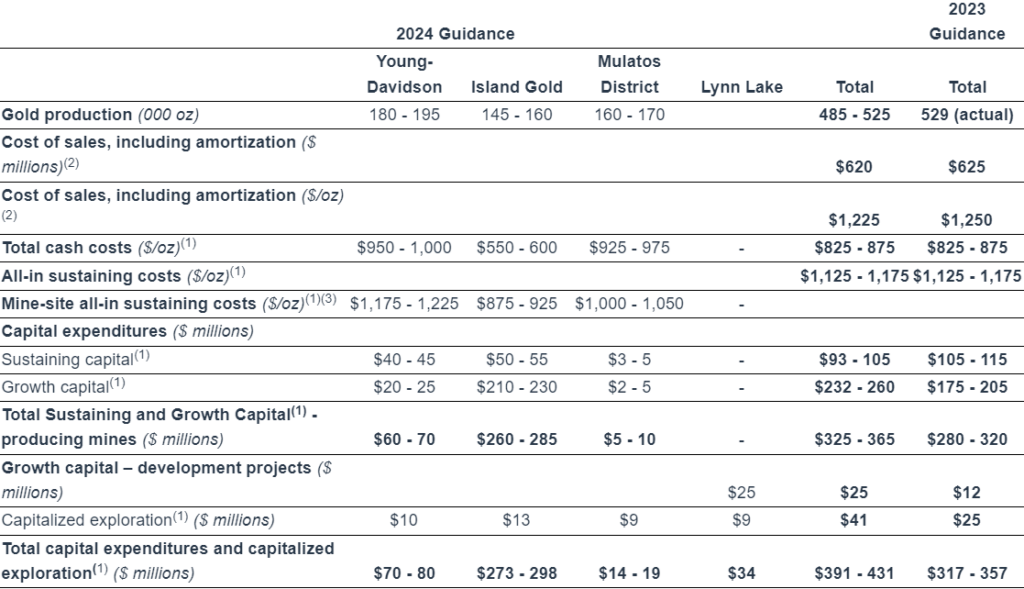
(1) Refer to the “Non-GAAP Measures and Additional GAAP” disclosure at the end of this press release for a description of these measures.
(2) Cost of sales includes mining and processing costs, royalties, and amortization expense, and is calculated based on the mid-point of total cash cost guidance.
(3) For the purposes of calculating mine-site all-in sustaining costs at individual mine sites, the Company does not include an allocation of corporate and administrative and share based compensation expenses to the mine sites.
Gold production in 2024 is expected to range between 485,000 and 525,000 ounces, a 3% increase from the previous three-year guidance provided in January 2023 (based on the mid-point). The increase is driven by higher expected production from the Mulatos District through residual leaching of the Mulatos leach pad, in addition to ongoing production from La Yaqui Grande. Production is expected to be slightly higher during the first half of 2024 with the recovery of ounces through residual leaching at Mulatos expected to decline through the year.
Total cash costs and AISC are expected to be consistent with 2023. Costs are expected to be towards the upper end of guidance to start the year and trend lower through the year reflecting declining rates of production from residual leaching at Mulatos.
AISC guidance has increased 12% relative to previous guidance (based on the mid-point) with the majority related to the increase in production from the Mulatos District through residual leaching, the stronger Mexican peso, as well as inflation, partly offset by lower sustaining capital.
The main driver of the increase in AISC is higher costs at the Mulatos District. La Yaqui Grande is expected to supply approximately 75% of Mulatos District production at a similar low-cost structure as 2023. The remaining production is expected to come from residual leaching of the main Mulatos leach pad which carries higher reported AISC of approximately $1,850 per ounce. The majority of these costs were previously incurred and recorded in inventory. The cash component to recover these ounces in 2024 is expected to be approximately $800 per ounce providing stronger free cash flow than implied by the higher reportable costs.
Additionally, the stronger Mexican Peso of 17:1 (MXN:USD), compared to 20:1 in previous guidance, increased costs by approximately $20 per ounce. The other key component of the increase in costs is inflation of 4% company-wide, with the largest driver being ongoing labour inflation, particularly in Canada.
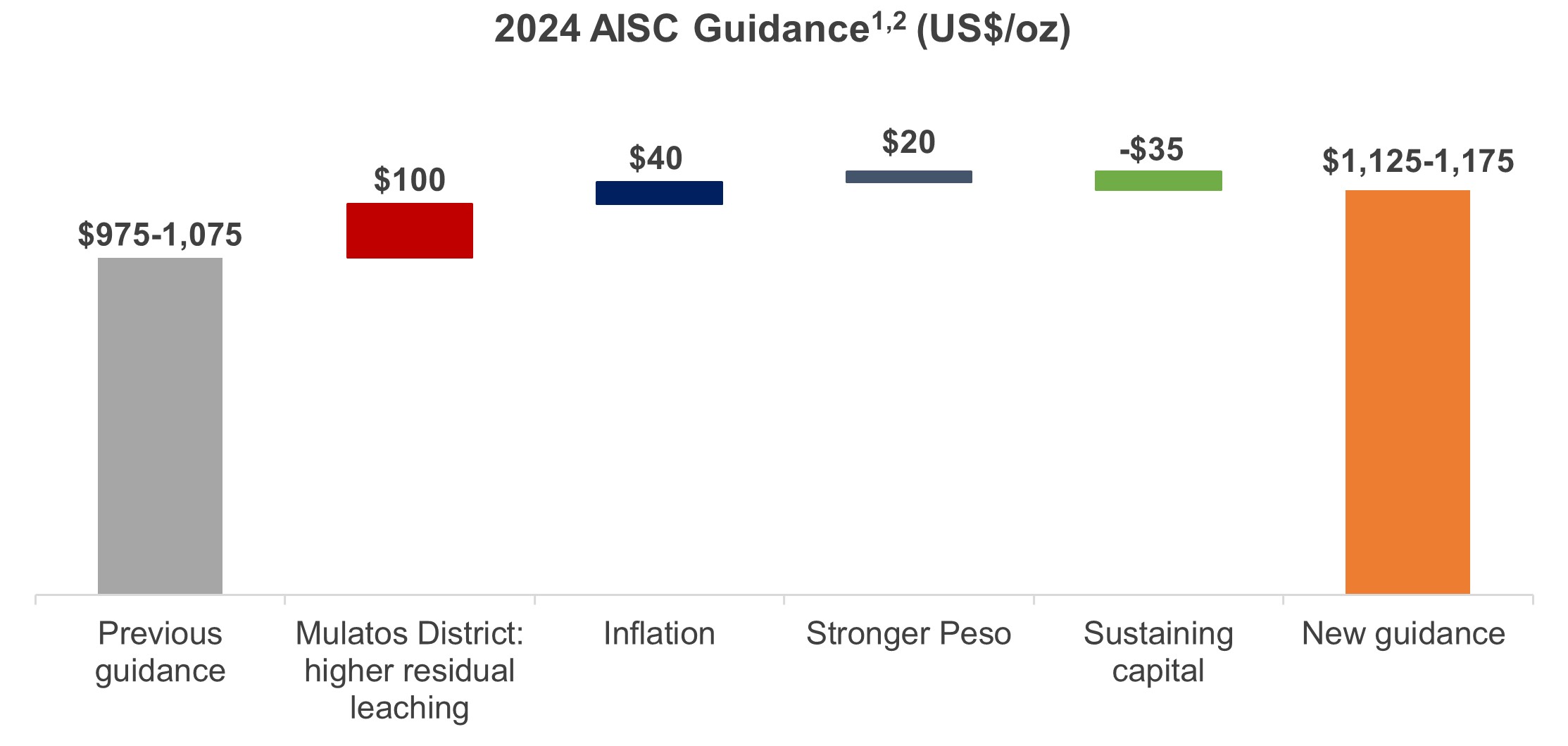
(1) Refer to the “Non-GAAP Measures and Additional GAAP” disclosure at the end of this press release for a description of these measures.
(2) Total consolidated all-in sustaining costs include corporate and administrative and share based compensation expenses.
Capital spending is expected to increase from 2023 reflecting inflation, higher capital at Island Gold and Lynn Lake, and an increased capitalized exploration budget. The largest driver of the increase in capital at Island Gold is for a planned tailings lift to be completed in 2024, as well as increased underground development costs, reflecting labour and cost inflation. Capital spending on the Lynn Lake project is expected to more than double the amount spent in 2023. Spending at Lynn Lake will be focused on upgrades to site access and infrastructure, including early work on the power line upgrade, in advance of a construction decision anticipated in 2025. Capital spending is expected to be balanced between the first and second half of the year.
Given the strong profitability of the Mulatos operation in 2023, the Company expects to pay significantly higher cash tax payments in Mexico in 2024, which includes the 2023 year-end tax payment due in the first quarter. Combined with an expected decrease in costs through the year, the Company expects stronger free cash flow starting in the second quarter of 2024.
2024 – 2026 Guidance: Operating Mines
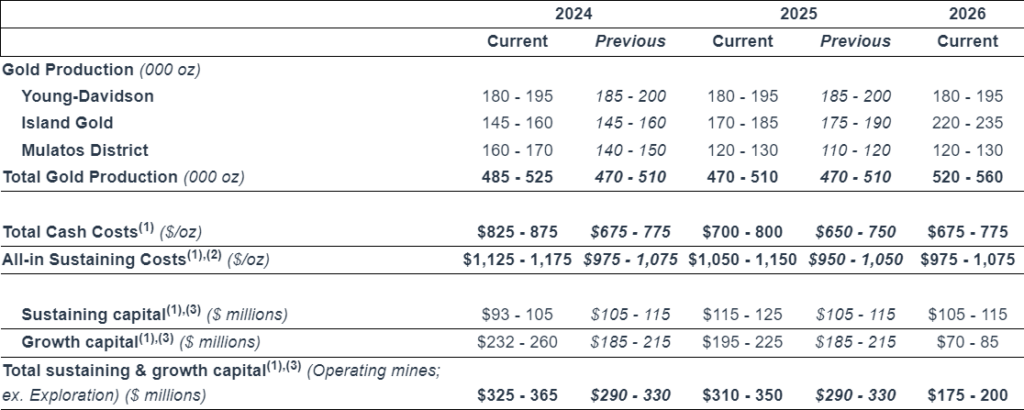
(1) Refer to the “Non-GAAP Measures and Additional GAAP” disclosure at the end of this press release for a description of these measures.
(2) All-in sustaining cost guidance for 2025 and 2026 includes the same assumptions for G&A and stock based compensation as included in 2024.
(3) Sustaining and growth capital guidance is for producing mines and excludes capital for Lynn Lake and other development projects, and capitalized exploration.
Consistent with previous guidance, gold production is expected to decrease slightly in 2025 reflecting the end of residual leaching at the main Mulatos leach pad, partly offset by further low-cost growth from Island Gold. The completion of the Phase 3+ Expansion at Island Gold is expected to drive production approximately 10% higher into 2026, from 2025.
Production guidance for 2026 excludes any production from the higher-grade PDA project which represents an excellent opportunity for additional production within the Mulatos District. A development plan outlining this upside potential at PDA is expected to be completed during the first quarter of 2024. Looking into 2027 and beyond, the Lynn Lake project represents further growth potential as detailed in the 2023 Feasibility Study which outlined another long-life, low-cost asset in Canada, with attractive economics and significant exploration upside.
Total cash costs and AISC in 2025 are expected to decrease 12% and 4%, respectively, from 2024. This is expected to be driven by low-cost growth from Island Gold, and the end of higher-cost residual leaching at Mulatos. A further increase in low-cost production at Island Gold is expected to drive costs lower into 2026, representing a 15% decrease in total cash costs, and 11% decrease in AISC, relative to 2024.
Capital spending at existing operations (excluding PDA and Lynn Lake) is expected to decrease 4% in 2025, reflecting lower capital at Mulatos and Island Gold. The increase in capital relative to previous guidance is primarily driven by inflation. A more substantial decrease in capital is expected in 2026 with the completion of the Phase 3+ Expansion at Island Gold. Sustaining capital spending at existing operations is expected to increase slightly in 2025 and 2026.

(1) Production and AISC are based on mid-point of guidance.
(2) Refer to the “Non-GAAP Measures and Additional GAAP” disclosure at the end of this press release for a description of these measures.
(3) Total consolidated all-in sustaining costs include corporate and administrative and share based compensation expenses.
Young-Davidson
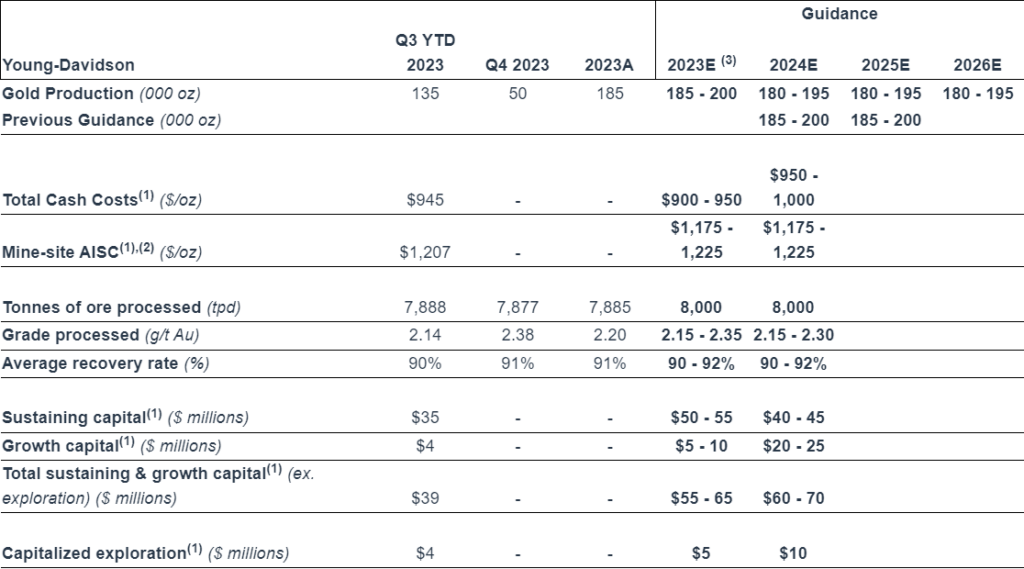
(1) Refer to the “Non-GAAP Measures and Additional GAAP” disclosure at the end of this press release and the Q3 2023 MD&A for a description and calculation of these measures.
(2) For the purposes of calculating mine-site all-in sustaining costs at individual mine sites, the Company does not include an allocation of corporate and administrative and share based compensation expenses to the mine sites.
(3) Refers to 2023 guidance announced on January 12, 2023.
Gold production at Young-Davidson is expected to remain consistent with 2023 over the next three years reflecting similar grades and mining and processing rates.
Grades mined and processed are expected to range between 2.15 and 2.30 grams per tonne of gold (“g/t Au”) in 2024 and remain at similar levels through 2026. Grades mined are expected to increase in 2027 and beyond and average closer to Mineral Reserve grade, as YD West becomes more of a significant contributor to production.
Total cash costs are expected to increase approximately 5% from 2023 guidance reflecting ongoing cost inflation with the largest driver being labour inflation in Northern Ontario. Mine-site AISC are expected to be consistent with 2023 with the increase in total cash costs offset by lower sustaining capital. Mine-site AISC are expected to increase in 2025 and 2026 reflecting slightly higher sustaining capital.
Capital spending in 2024 (excluding exploration) is expected to range between $60 and $70 million. This is up from 2023 reflecting inflation and higher growth capital, partly offset by lower sustaining capital. The largest component of the increase in growth capital is for an expansion of the water treatment plant at the operation. Capital spending is expected to remain at similar levels in 2025 and 2026.
Young-Davidson remains on track to generate more than $100 million of free cash flow for the third consecutive year in 2023. At current gold prices, the operation is well positioned to generate similar free cash flow in 2024 and over the long term given its 15-year Mineral Reserve life.
Island Gold
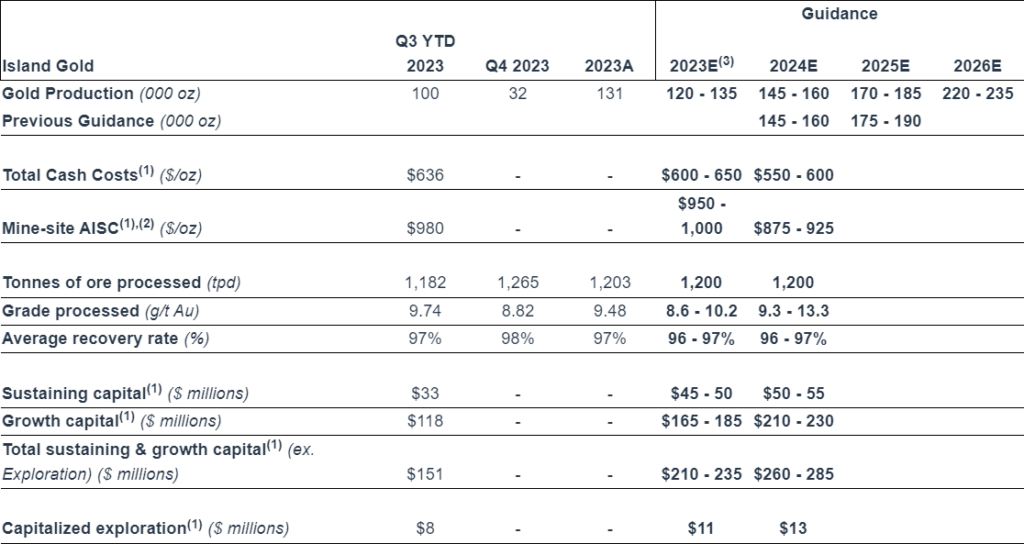
(1) Refer to the “Non-GAAP Measures and Additional GAAP” disclosure at the end of this press release and the Q3 2023 MD&A for a description and calculation of these measures.
(2) For the purposes of calculating mine-site all-in sustaining costs at individual mine sites, the Company does not include an allocation of corporate and administrative and share based compensation expenses to the mine sites.
(3) Refers to 2023 guidance announced on January 12, 2023.
Production guidance for Island Gold in 2024 is consistent with previous guidance and represents a 16% increase from 2023 production, reflecting higher grades. Grades are expected to increase further into 2025 and combined with higher mining and processing rates towards the latter part of the year, this is expected to drive an additional 16% increase in production. Following the completion of the Phase 3+ Expansion in 2026, mining rates are expected to begin ramping up towards 2,400 tpd contributing to a further 28% increase in production. As outlined in the Phase 3+ Study, production rates are expected to increase to average 287,000 ounces per year in 2027 and beyond.
Total cash costs and mine-site AISC are expected to decrease 8% from 2023 reflecting higher grades, partly offset by ongoing cost inflation, particularly labour in Northern Ontario. Costs are expected to decrease further into 2025 and 2026 reflecting higher grades in 2025, and higher mining rates and productivity improvements with the completion of the Phase 3+ Expansion in 2026.
Capital spending at Island Gold (excluding exploration) is expected to be between $260 and $285 million in 2024. This is up from 2023 reflecting the timing of capital spending, with some capital on the Phase 3+ Expansion expected to be spent late in 2023 deferred into 2024, additional capital for a planned tailings dam lift, as well as cost and labour inflation. Construction activities in 2024 will be focused on the shaft sinking, which began in December 2023, and the start of work on the paste plant and mill expansion. Capital spending is expected to remain at similar levels in 2025 and decrease substantially in 2026 with the Phase 3+ Expansion on schedule to be completed during the first half of 2026.
Mulatos District
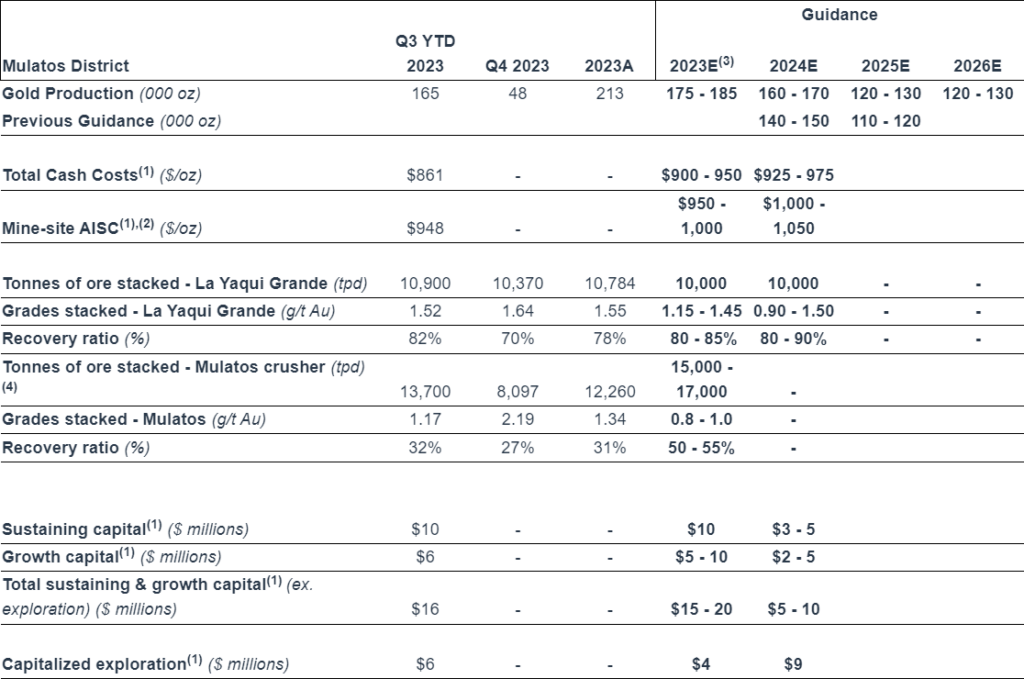
(1) Refer to the “Non-GAAP Measures and Additional GAAP” disclosure at the end of this press release and the Q3 2023 MD&A for a description and calculation of these measures.
(2) For the purposes of calculating mine-site all-in sustaining costs at individual mine sites, the Company does not include an allocation of corporate and administrative and share based compensation expenses to the mine sites.
(3) Refers to 2023 guidance announced on January 12, 2023.
Combined gold production from the Mulatos District is expected to be between 160,000 and 170,000 ounces in 2024, a 14% increase from previous guidance (based on the mid-point). The higher production is expected to come from residual leaching of the main Mulatos leach pad which carries higher reported costs; however, is very profitable from a cash flow perspective with the majority of these costs previously incurred and recorded in inventory.
La Yaqui Grande is expected to provide approximately 75% of Mulatos District production in 2024. The remaining production is expected to come from residual leaching of the Mulatos leach pad with mining in the main Mulatos pit having ended in July 2023, and stacking of stockpiled ore on the pad concluding in December 2023. Production is expected to be weighted towards the first half of the year and decline through the year. This reflects higher grades at La Yaqui Grande during the first half of the year, and declining rates of production through residual leaching.
Total cash costs and mine-site AISC in 2024 are expected to be similar to 2023, though higher than what was incorporated into previous guidance reflecting the increase in production expected from residual leaching. The ounces recovered through residual leaching are expected to carry a reported mine-site AISC of approximately $1,850 per ounce with the majority of these costs having been previously incurred and sitting in inventory. The cash component to be spent to recover these ounces in 2024 is expected to be approximately $800 per ounce, providing significant free cash flow. Total cash costs and AISC are expected to increase slightly through the year driven primarily by the grade sequence at La Yaqui Grande.
Production guidance for 2025 was also increased to between 120,000 and 130,000 ounces reflecting slightly higher grades from La Yaqui Grande compared to previous guidance. Production is expected to decrease relative to 2024 with no production currently anticipated from residual leaching of the main Mulatos leach pad beyond 2024.
Production is expected to remain at similar levels in 2026 with guidance based on La Yaqui Grande only. Guidance for 2026 excludes the higher-grade PDA project which represents an excellent opportunity for additional production within the Mulatos District. A development plan outlining this upside potential at PDA is expected to be completed during the first quarter of 2024.
Capital spending is expected to total $5 to $10 million in 2024, down from 2023 with no major capital projects remaining at La Yaqui Grande. Capital spending is expected to remain at similar levels in 2025 and 2026, excluding PDA. Additional details on the PDA development plan are expected to be published in the first quarter of 2024.
2024 Global Operating and Development Capital Budget
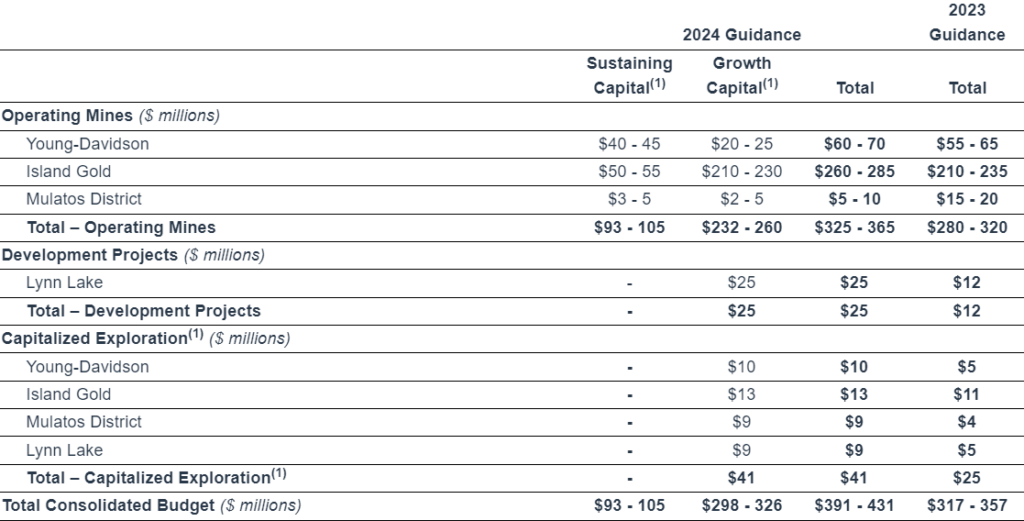
(1) Refer to the “Non-GAAP Measures and Additional GAAP” disclosure at the end of this press release for a description and calculation of these measures.
2024 Capital Budget for Lynn Lake
Capital spending on the Lynn Lake project, excluding exploration, is expected to total $25 million. This is up from 2023 reflecting planned upgrades to the site access and infrastructure. With approval of the Environmental Impact Statement and Provincial licenses received in March 2023, and the positive Feasibility Study completed in August 2023, the focus in 2024 will be on further de-risking and advancing the project ahead of an anticipated construction decision in 2025. This includes finishing detailed engineering, which is 75% complete, upgrading road access, and early work on the power line upgrade.
The majority of the $25 million capital budget in 2024 is spending included as initial capital in the 2023 Feasibility Study. Additionally, $9 million has been budgeted for exploration at Lynn Lake for a total capital budget of $34 million.
2024 Exploration Budget
The global exploration budget for 2024 is $62 million, a 24% increase from expected spending of $50 million in 2023. The increase reflects expanded budgets across all key assets following up on broad based exploration success in 2023. Island Gold and the Mulatos District account for approximately 60% of the total budget with $19 million planned for each asset. This is followed by $12 million at Young-Davidson, $9 million at Lynn Lake and $2 million at Golden Arrow. Approximately $41 million, or 66% of the 2024 budget will be capitalized.
Island Gold
A total of $19 million has been budgeted for exploration at Island Gold in 2024, up from $14 million in 2023 with both a larger near mine and regional exploration program.
The 2024 exploration program will follow up on a successful 2023 program with high-grade gold mineralization extended laterally to the West and East as well as within multiple structures within the hanging wall and footwall (see press release dated November 9, 2023). With the deposit open laterally and at depth, this ongoing exploration success highlights the significant potential for further growth in Mineral Reserves and Resources.
Consistent with the 2023 program, the majority of the 2024 mine exploration program will be comprised of underground drilling with 41,000 metres (“m”) planned. The focus will be the definition of new Mineral Reserves and Resources in proximity to existing production horizons and infrastructure, as well as the conversion of the large existing Mineral Resource base to Reserves. This includes drilling across the strike extent of main Island Gold Deposit (E1E and C-Zones), as well as within a growing number of newly defined hanging-wall and footwall zones. These potential high-grade Mineral Reserve and Resource additions would be low cost to develop and could be incorporated into the mine plan and mined within the next several years providing increased operational flexibility, and further increasing the value of the operation.
Additionally, 12,500 m of surface exploration drilling has been budgeted targeting 1) high potential areas within the Island West, Main and East ore shoots, 2) the up-plunge extension of the Island West ore shoot, and 3) evaluating the potential for high-grade mineralized hanging wall structures near surface.
To support the underground exploration drilling program, 460 m of underground exploration drift development is planned to extend drill platforms on the 850, 945, and 1025-levels. In addition to the exploration budget, 32,000 m of underground delineation drilling has been planned and included in sustaining capital for Island Gold which will be focused on the conversion of the large Mineral Resource base to Mineral Reserves.
The regional exploration program has also been expanded to 10,000 m, up from 7,500 m in 2023. The 2024 program will follow up on high-grade mineralization intersected at the Pine-Breccia and 88-60 targets, located 4 kilometres (“km”) and 7 km, respectively, from the Island Gold mine. Drilling will also be completed in proximity to the past-producing Cline and Edwards mines, as well as at the Island Gold North Shear target. A comprehensive data compilation project will also commence across the broader 40,000 hectare Manitou land package that was acquired in 2023 in support of future exploration targeting.
Mulatos District
A total of $19 million has been budgeted at Mulatos for exploration in 2024, similar to expected spending in 2023. The near-mine and regional drilling program is expected to total 55,000 m. This includes 27,000 m of surface exploration drilling at PDA and the surrounding area. This drilling will follow up on another successful year of exploration at PDA with high-grade mineralization expanded in multiple directions beyond Mineral Reserves and Resources at the higher-grade underground deposit.
Given the ongoing growth of the PDA deposit, other higher-grade sulphide opportunities will be targeted within the Mulatos District in 2024. This includes an initial 2,000 m of follow up drilling at the previously mined Cerro Pelon deposit where high-grade mineralization was intersected north of the mined-out open pit in 2015. This included 14.47 g/t Au over 50.30 m (15PEL012) and 9.65 g/t Au over 34.60 m (15PEL020).
Within the regional exploration program, 26,000 m has been budgeted. Nearly half will be focused on the Capulin target located 4 km from the Mulatos pit where significant, wide intervals of oxide and sulphide gold mineralization were intersected in 2023. This included the previously reported 2.01 g/t Au over 82.45 m core length (23REF012), and 2.73 g/t Au over 120.85 m core length, including 9.31 g/t Au over 29.05 m (23REF022). The remainder of the regional program will be focused on drilling at other high priority targets, including Cerro Pelon West and South.
Young-Davidson
A total of $12 million has been budgeted for exploration at Young-Davidson in 2024, up from $8 million in 2023. This includes 21,600 m of underground exploration drilling, and 1,070 m of underground exploration development to extend drill platforms on multiple levels.
The majority of the underground exploration drilling program will be focused on extending mineralization within the Young-Davidson syenite, which hosts the majority of Mineral Reserves and Resources. Drilling will also test the hanging wall and footwall of the deposit where higher grades have been previously intersected.
Young-Davidson has a 15-year Mineral Reserve life as of the end of 2022 and has maintained at least a 13-year Mineral Reserve life since 2011 reflecting ongoing exploration success. With the deposit open at depth and to the west, there is excellent potential for this track record to continue.
The regional program has been expanded with 7,000 m of surface drilling planned in 2024, up from 5,000 m in 2023. The focus will be on testing multiple near-surface targets across the 5,900 hectare Young-Davidson Property that could potentially provide supplemental mill feed.
Additionally, $2 million is budgeted at Golden Arrow with 5,000 m of drilling planned. The focus of the drilling will be the conversion of existing Mineral Resources into Reserves, and testing near-deposit and early stage exploration targets across the property. Geotechnical and condemnation drilling will also be conducted as part of a development plan for the project. The Golden Arrow deposit is located 95 km from the Young-Davidson mill and is being evaluated as a source of supplemental mill feed.
Lynn Lake
A total of $9 million has been budgeted for exploration at the Lynn Lake project in 2024, up from $5 million in 2023. This includes 15,500 m of drilling focused on the conversion of Mineral Resources to Mineral Reserves at the Burnt Timber and Linkwood deposits, and to evaluate the potential for Mineral Resources at Maynard, an advanced stage greenfield target.
Burnt Timber and Linkwood contain Inferred Mineral Resources totaling 1.6 million ounces grading 1.1 g/t Au (44 million tonnes) as of December 31, 2022. The Company sees excellent potential for this to be converted into a smaller, higher quality Mineral Reserve which could be incorporated into the Lynn Lake project given its proximity to the planned mill. This represents potential production and economic upside to the Feasibility Study completed on Lynn Lake in August 2023.
Burnt Timber and Linkwood are accessible by an all-season gravel road from Highway 397, 24 km and 28 km from the proposed MacLellan mill, respectively. The Maynard target is located 5 km northwest of the Linkwood deposit, 1 km from the all-season gravel road, and 20 km from the proposed MacLellan mill.
The Company will also continue evaluating and advancing a pipeline of prospective exploration targets within the 58,000-hectare Lynn Lake Property in 2024.
Assumptions and Sensitivities
| Assumptions & Expenses | 2024 | |
| Gold price | $/oz | $1,800 |
| Canadian dollar | USD/CAD | $0.75:1 |
| Mexican peso | MXN/USD | 17.0:1 |
| Amortization | $/oz | $375 |
| General & Administrative(1) | $ millions | $28 |
(1) Excludes stock-based compensation.
The 2024 to 2026 production forecast, operating cost and capital estimates are based on a gold price assumption of $1,800 per ounce, a USD/CAD foreign exchange rate of $0.75:1 and MXN/USD foreign exchange rate of 17.0:1. Cost assumptions for 2025 and 2026 are based on 2024 input costs and have not been increased to reflect potential inflation in those years. These estimates may be updated in the future to reflect inflation beyond what is currently forecast for 2024.
Amortization expense in 2024 is expected to total approximately $375 per ounce, consistent with 2023 amortization. General and administrative expenses in 2024 are expected to total $28 million (excluding stock-based compensation), consistent with 2023 spending.
| Sensitivities | 2024 | Operating Sites Local Currency Exposure | Change | Free Cash Flow Sensitivity (1) |
| Gold price | $1,800 | – | $100 | ~$50 million |
| USD/CAD | $0.75:1 | 95% | $0.05 | ~$30 – 35 million |
| MXN/USD | 17.0:1 | 40% | 1.00 | ~$3 – 4 million |
(1) Free cash flow sensitivities include the impact of foreign exchange and short-term gold hedging arrangements noted below.
Current foreign exchange and gold hedging commitments
The Company has entered into the following foreign exchange and short-term hedging arrangements to date:
- Canadian dollar: approximately 55% of Canadian dollar-denominated operating and capital costs for 2024 have been hedged, ensuring a maximum USD/CAD foreign exchange rate of $0.75:1 and allowing the Company to participate in weakness in the USD/CAD down to an average rate of $0.70:1 (if the USD/CAD rate weakens beyond $0.70:1, the average rate increases to $0.72:1).
- Mexican peso: approximately 17% of Mexican peso-denominated operating and capital costs in 2024 have been hedged, ensuring a minimum MXN/USD foreign exchange rate of 18.0:1 and allowing the Company to participate in weakness in the MXN/USD up to an average rate of 19.8:1.
- Gold collar contracts: The Company also periodically enters into short term gold hedging arrangements. Currently, the Company has hedged 69,750 ounces in 2024, ensuring an average minimum gold price of $1,926 per ounce and participation up to an average gold price of $2,356 per ounce. This represents approximately 14% of 2024 production (based on mid-point of guidance).
Qualified Persons
Chris Bostwick, Alamos’ Senior Vice President, Technical Services, who is a qualified person within the meaning of National Instrument 43-101 Standards of Disclosure for Mineral Projects, has reviewed and approved the scientific and technical information contained in this press release.
About Alamos
Alamos is a Canadian-based intermediate gold producer with diversified production from three operating mines in North America. This includes the Young-Davidson and Island Gold mines in northern Ontario, Canada and the Mulatos mine in Sonora State, Mexico. Additionally, the Company has a strong portfolio of growth projects, including the Phase 3+ Expansion at Island Gold, and the Lynn Lake project in Manitoba, Canada. Alamos employs more than 1,900 people and is committed to the highest standards of sustainable development. The Company’s shares are traded on the TSX and NYSE under the symbol “AGI”.
FOR FURTHER INFORMATION, PLEASE CONTACT:
Scott K. Parsons
Senior Vice President, Investor Relations
(416) 368-9932 x 5439
All amounts are in United States dollars, unless otherwise stated.
The TSX and NYSE have not reviewed and do not accept responsibility for the adequacy or accuracy of this release.
Cautionary Note
This press release contains or incorporates by reference “forward-looking statements” and “forward-looking information” as defined under applicable Canadian and U.S. securities laws. All statements, other than statements of historical fact, which address events, results, outcomes or developments that the Company expects to occur are, or may be deemed to be, forward-looking statements and are generally, but not always, identified by the use of forward-looking terminology such as “expect”, “assume”, “estimate”, “potential”, “outlook”, “on track”, “continue”, “ongoing”, “will”, “believe”, “anticipate”, “intend”, “estimate”, “forecast”, “budget”, “target”, “plan” or variations of such words and phrases and similar expressions or statements that certain actions, events or results “may”, “could”, “would”, “might” or “will” be taken, occur or be achieved or the negative connotation of such terms. Forward-looking statements contained in this press release are based on expectations, estimates and projections as of the date of this press release.
Forward-looking statements in this press release include, but may not be limited to, information as to strategy, plans, expectations or future financial or operating performance, such as expectations and guidance regarding: costs (including cash costs, AISC, capital expenditures, exploration spending), cost structure and anticipated declining cost profile; budgets; growth capital; sustaining capital; cash flow; foreign exchange rates; gold and other metal price assumptions; anticipated gold production, production rates, timing of production, production potential and growth; returns to stakeholders; the mine plan for and expected results from the Phase 3+ expansion at Island Gold and timing of its progress and completion; feasibility of, development of, and mine plan for, the Lynn Lake project and potential growth in production resulting from the Lynn Lake project; development plan for the Puerto Del Air (PDA) project (Mulatos); mining, milling and processing and rates; mined and processed gold grades and weights; mine life; Mineral Reserve life; planned exploration, drilling targets, exploration potential and results; as well as any other statements related to the Company’s production forecasts and plans, expected sustaining costs, expected improvements in cash flows and margins, expectations of changes in capital expenditures, expansion plans, project timelines, and expected sustainable productivity increases, expected increases in mining activities and corresponding cost efficiencies, cost estimates, sufficiency of working capital for future commitments, Mineral Reserve and Mineral Resource estimates, and other statements or information that express management’s expectations or estimates of future performance, operational, geological or financial results.
The Company cautions that forward-looking statements are necessarily based upon several factors and assumptions that, while considered reasonable by management at the time of making such statements, are inherently subject to significant business, economic, technical, legal, political and competitive uncertainties and contingencies. Known and unknown factors could cause actual results to differ materially from those projected in the forward-looking statements, and undue reliance should not be placed on such statements and information.
Such factors and assumptions underlying the forward-looking statements in this press release, include (without limitation): changes to current estimates of Mineral Reserves and Resources; changes to production estimates (which assume accuracy of projected ore grade, mining rates, recovery timing and recovery rate estimates and may be impacted by unscheduled maintenance, weather issues, labour and contractor availability and other operating or technical difficulties); operations may be exposed to new diseases, epidemics and pandemics, including any ongoing or future effects of COVID-19 (and any related ongoing or future regulatory or government responses) and its impact on the broader market and the trading price of the Company’s shares; provincial, state and federal orders or mandates (including with respect to mining operations generally or auxiliary businesses or services required for the Company’s operations) in Canada, Mexico, the United States and Türkiye, all of which may affect many aspects of the Company’s operations including the ability to transport personnel to and from site, contractor and supply availability and the ability to sell or deliver gold doré bars; fluctuations in the price of gold or certain other commodities such as, diesel fuel, natural gas and electricity; changes in foreign exchange rates (particularly the Canadian dollar, U.S. dollar, Mexican peso and Turkish Lira); the impact of inflation; changes in the Company’s credit rating; any decision to declare a dividend; employee and community relations; labour and contractor availability (and being able to secure the same on favourable terms); the impact of litigation and administrative proceedings (including but not limited to the investment treaty claim announced on April 20, 2021 against the Republic of Türkiye by the Company’s wholly-owned Netherlands subsidiaries, Alamos Gold Holdings Coöperatief U.A. and Alamos Gold Holdings B.V., the application for judicial review of the positive Decision Statement issued by the Ministry of Environment and Climate Change Canada commenced by the Mathias Colomb Cree Nation (MCCN) in respect of the Lynn Lake project and the MCCN’s corresponding internal appeal of the Environment Act Licences issued by the Province of Manitoba for the project) and any resulting court, arbitral and/or administrative decisions; disruptions affecting operations; availability of and increased costs associated with mining inputs and labour; permitting, construction or other delays with the Phase 3+ expansion or the Lynn Lake project; delays in the completion of an updated development plan for PDA and/or production from PDA (Mulatos); exploration opportunities and potential in the Mulatos District, at Young Davidson and/or Island Gold not coming to fruition; inherent risks and hazards associated with mining and mineral processing including environmental hazards, industrial accidents, unusual or unexpected formations, pressures and cave-ins; the risk that the Company’s mines may not perform as planned; uncertainty with the Company’s ability to secure additional capital to execute its business plans; the speculative nature of mineral exploration and development, including the risks of obtaining and maintaining necessary licenses, permits and authorizations, contests over title to properties; expropriation or nationalization of property; political or economic developments in Canada, Mexico, the United States, Türkiye and other jurisdictions in which the Company may carry on business in the future; increased costs and risks related to the potential impact of climate change; changes in national and local government legislation, controls or regulations (including tax and employment legislation) in jurisdictions in which the Company does or may carry on business in the future; the costs and timing of construction and development of new deposits; risk of loss due to sabotage, protests and other civil disturbances; disruptions in the maintenance or provision of required infrastructure and information technology systems, the impact of global liquidity and credit availability and the values of assets and liabilities based on projected future cash flows; risks arising from holding derivative instruments; and business opportunities that may be pursued by the Company.
For a more detailed discussion of such risks and other factors that may affect the Company’s ability to achieve the expectations set forth in the forward-looking statements contained in this press release, see the Company’s latest 40-F/Annual Information Form and Management’s Discussion and Analysis, each under the heading “Risk Factors” available on the SEDAR+ website at www.sedarplus.ca or on EDGAR at www.sec.gov. The foregoing should be reviewed in conjunction with the information and risk factors and assumptions found in this press release.
The Company disclaims any intention or obligation to update or revise any forward-looking statements whether as a result of new information, future events or otherwise, except as required by applicable law.
Cautionary Note to U.S. Investors
All resource and reserve estimates included in this press release or documents referenced in this press release have been prepared in accordance with Canadian National Instrument 43-101 – Standards of Disclosure for Mineral Projects (“NI 43-101”) and the Canadian Institute of Mining, Metallurgy and Petroleum (the “CIM”) – CIM Definition Standards on Mineral Resources and Mineral Reserves, adopted by the CIM Council, as amended (the “CIM Standards”). NI 43-101 is a rule developed by the Canadian Securities Administrators, which established standards for all public disclosure an issuer makes of scientific and technical information concerning mineral projects. Mining disclosure in the United States was previously required to comply with SEC Industry Guide 7 (“SEC Industry Guide 7”) under the United States Securities Exchange Act of 1934, as amended. The U.S. Securities and Exchange Commission (the “SEC”) has adopted final rules, to replace SEC Industry Guide 7 with new mining disclosure rules under sub-part 1300 of Regulation S-K of the U.S. Securities Act (“Regulation S-K 1300”) which became mandatory for U.S. reporting companies beginning with the first fiscal year commencing on or after January 1, 2021. Under Regulation S-K 1300, the SEC now recognizes estimates of “Measured Mineral Resources”, “Indicated Mineral Resources” and “Inferred Mineral Resources”. In addition, the SEC has amended its definitions of “Proven Mineral Reserves” and “Probable Mineral Reserves” to be substantially similar to international standards.
Investors are cautioned that while the above terms are “substantially similar” to CIM Definitions, there are differences in the definitions under Regulation S-K 1300 and the CIM Standards. Accordingly, there is no assurance any mineral reserves or mineral resources that the Company may report as “proven mineral reserves”, “probable mineral reserves”, “measured mineral resources”, “indicated mineral resources” and “inferred mineral resources” under NI 43-101 would be the same had the Company prepared the mineral reserve or mineral resource estimates under the standards adopted under Regulation S-K 1300. U.S. investors are also cautioned that while the SEC recognizes “measured mineral resources”, “indicated mineral resources” and “inferred mineral resources” under Regulation S-K 1300, investors should not assume that any part, or all of the mineralization in these categories will ever be converted into a higher category of mineral resources or into mineral reserves. Mineralization described using these terms has a greater degree of uncertainty as to its existence and feasibility than mineralization that has been characterized as reserves. Accordingly, investors are cautioned not to assume that any measured mineral resources, indicated mineral resources, or inferred mineral resources that the Company reports are or will be economically or legally mineable.
Cautionary non-GAAP Measures and Additional GAAP Measures
Note that for purposes of this section, GAAP refers to IFRS. The Company believes that investors use certain non-GAAP and additional GAAP measures as indicators to assess gold mining companies. They are intended to provide additional information and should not be considered in isolation or as a substitute for measures of performance prepared with GAAP.
“Cash flow from operating activities before changes in non-cash working capital” is a non-GAAP performance measure that could provide an indication of the Company’s ability to generate cash flows from operations and is calculated by adding back the change in non-cash working capital to “cash provided by (used in) operating activities” as presented on the Company’s consolidated statements of cash flows. “Cash flow per share” is calculated by dividing “cash flow from operations before changes in working capital” by the weighted average number of shares outstanding for the period. “Free cash flow” is a non-GAAP performance measure that is calculated as cash flows from operations net of cash flows invested in mineral property, plant and equipment and exploration and evaluation assets as presented on the Company’s consolidated statements of cash flows and that would provide an indication of the Company’s ability to generate cash flows from its mineral projects. “Mine site free cash flow” is a non-GAAP measure which includes cash flow from operating activities at, less capital expenditures at each mine site. “Return on equity” is defined as earnings from continuing operations divided by the average total equity for the current and previous year. “Mining cost per tonne of ore” and “cost per tonne of ore” are non-GAAP performance measures that could provide an indication of the mining and processing efficiency and effectiveness of the mine. These measures are calculated by dividing the relevant mining and processing costs and total costs by the tonnes of ore processed in the period. “Cost per tonne of ore” is usually affected by operating efficiencies and waste-to-ore ratios in the period. “Sustaining capital” are expenditures that do not increase annual gold ounce production at a mine site and excludes all expenditures at the Company’s development projects. “Growth capital” are expenditures primarily incurred at development projects and costs related to major projects at existing operations, where these projects will materially benefit the mine site. “Capitalized exploration” are expenditures that meet the IFRS definition for capitalization, and are incurred to further expand the known Mineral Reserve and Resource at existing operations or development projects. “Total capital expenditures per ounce produced” is a non-GAAP term used to assess the level of capital intensity of a project and is calculated by taking the total growth and sustaining capital of a project divided by ounces produced life of mine. “Total cash costs per ounce”, “all-in sustaining costs per ounce”, “mine-site all-in sustaining costs”, and “all-in costs per ounce” as used in this analysis are non-GAAP terms typically used by gold mining companies to assess the level of gross margin available to the Company by subtracting these costs from the unit price realized during the period. These non-GAAP terms are also used to assess the ability of a mining company to generate cash flow from operations. There may be some variation in the method of computation of these metrics as determined by the Company compared with other mining companies. In this context, “total cash costs” reflects mining and processing costs allocated from in-process and doré inventory and associated royalties with ounces of gold sold in the period. Total cash costs per ounce are exclusive of exploration costs. “All-in sustaining costs per ounce” include total cash costs, exploration, corporate and administrative, share based compensation and sustaining capital costs. “Mine-site all-in sustaining costs” include total cash costs, exploration, and sustaining capital costs for the mine-site, but exclude an allocation of corporate and administrative and share based compensation. “Adjusted net earnings” and “adjusted earnings per share” are non-GAAP financial measures with no standard meaning under IFRS. “Adjusted net earnings” excludes the following from net earnings: foreign exchange gain (loss), items included in other loss, certain non-reoccurring items and foreign exchange gain (loss) recorded in deferred tax expense. “Adjusted earnings per share” is calculated by dividing “adjusted net earnings” by the weighted average number of shares outstanding for the period.
Additional GAAP measures that are presented on the face of the Company’s consolidated statements of comprehensive income and are not meant to be a substitute for other subtotals or totals presented in accordance with IFRS, but rather should be evaluated in conjunction with such IFRS measures. This includes “Earnings from operations”, which is intended to provide an indication of the Company’s operating performance, and represents the amount of earnings before net finance income/expense, foreign exchange gain/loss, other income/loss, and income tax expense. Non-GAAP and additional GAAP measures do not have a standardized meaning prescribed under IFRS and therefore may not be comparable to similar measures presented by other companies. A reconciliation of historical non-GAAP and additional GAAP measures are available in the Company’s latest Management’s Discussion and Analysis available online on the SEDAR+ website at www.sedarplus.ca or on EDGAR at www.sec.gov and at www.alamosgold.com.
Photos accompanying this announcement are available at:
https://www.globenewswire.com/NewsRoom/AttachmentNg/092ee4fd-6450-43b1-b5ff-d934c3476534
https://www.globenewswire.com/NewsRoom/AttachmentNg/233df61b-d294-4959-977d-a3760292352c

















